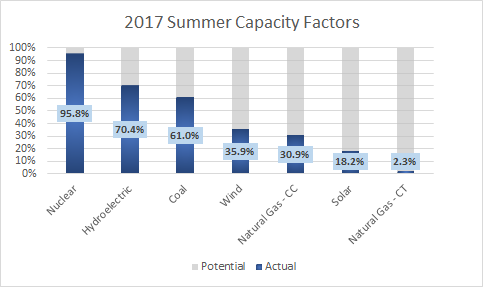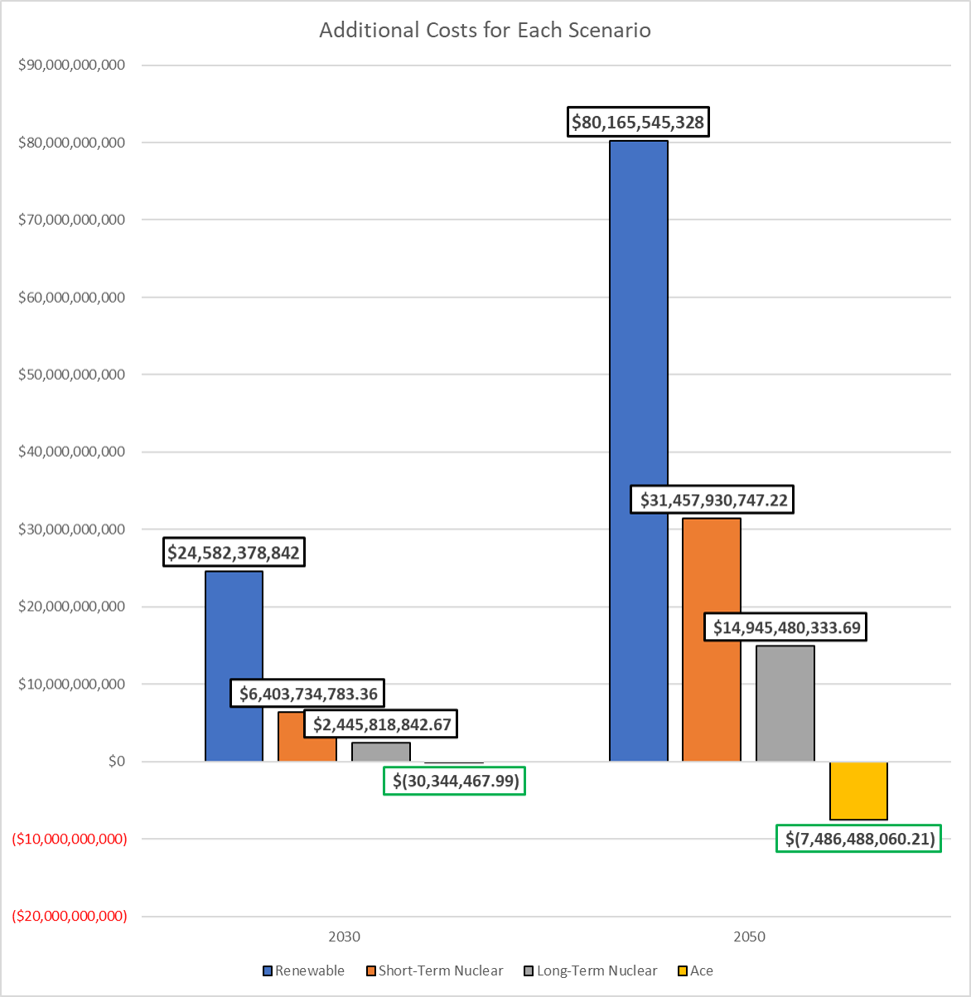One Korean Nuclear Reactor Would Produce As Much Electricity As All Minnesota Wind Turbines at a Much Lower Cost
Last week, Korean Electric Power (KEPCO) connected its second advanced pressure reactor (APR) 1400 nuclear reactor to the grid. This is significant because these power plants, with a generation capacity of 1,400 megawatts (MW), would be able to generate about as much electricity as the combined output of all the wind facilities in Minnesota, for a fraction of the cost.
Nuclear power plants are incredibly efficient, with capacity factors of 90 percent or higher. This means nuclear plants will generate about 90 percent of their theoretical output during the course of a year. As a result, building just one APR1400 reactor in Minnesota would generate about 11 million megawatt hours (MWh) per year, or about 19 percent of the electricity generated in the Minnesota in 2017.
In contrast, wind is inefficient, with capacity factors of about 35.9 percent. In other words, wind produced just 35.9 percent of its theoretical output in 2017, according to data from the Energy Information Administration. As a result, wind generated just over 11.1 million MWh, even though it could have theoretically generated 32.5 million MWh.
You can see the capacity factors for all types of Minnesota generation resources below. Nuclear, hydroelectric, and coal have the highest capacity factors, whereas wind, natural gas combined cycle plants, and solar had relatively low capacity factors. Combustion turbine natural gas plants are used primarily as peaking resources, and are designed to be used infrequently.

The inefficiency of wind is why it takes 2.3 times as many MW of installed capacity to generate the same quantity of electricity as nuclear power. Even the new “good” wind projects are supposed to have capacity factors just over 50 percent, meaning even in the best case scenario you’d have to build two wind turbines to generate the same quantity of electricity as a nuclear plant but this comparison is still too charitable to wind because unlike nuclear, we can’t control when that electricity would be generated.
As you can imagine, this inefficiency has enormous implications for cost.
The Energy Information Administration estimates the cost of building wind in the Midwestern region is around $1.5 million per MW. On the other hand, KEPCO has signed a contract to build four APR-1400 reactors in the United Arab Emirates at a turnkey cost of $3.6 million per MW. Now, pretending wind would operate at a 50 percent capacity factor, which it doesn’t, you’d need to spend about $3 million on wind turbines to get 1 MW of electricity from wind, and assuming a 90 percent capacity factor for nuclear, you’d spend around $4 million for 1 MW of electricity from a nuclear power plant.
Now, factor in that wind turbines only last for 20 years and the cost for wind become $9 million per MW of electricity generated over a 60 year period. In contrast, the APR1400, which is designed to last at least 60 years, would cost just $4 million over this time frame. Furthermore, these costs don’t even take into account the additional costs for transmission that is driven primarily by building wind turbines far away from population centers (like the Dakotas), and the cost of the natural gas or coal power plants needed to generate electricity when the wind isn’t blowing.
In our report, Doubling Down on Failure, we used capital numbers for nuclear from the Energy Information Administration which estimated the cost of advanced nuclear was around $6 million per MW, but if we had used the capital costs for the APR1400, rather than the EIA numbers, the costs of our nuclear scenarios would have been far lower.
In fact, once transmission, utility profits, and property taxes are taken into account, the “all-in” LCOE of the APR1400 would be $75.86 per MWh. In contrast, the “all-in” cost of wind is $113.56 per MWh, after accounting for transmission, load balancing, utility profits, and additional property taxes at a 44 percent capacity factor.
These cost differences have major implications for energy policy in Minnesota.
Our study found that the Short-Term Nuclear scenario, (achieving 80 percent carbon-free electricity using nuclear by 2030) would cost $58.2 billion through 2050 using EIA cost estimates for advanced nuclear, but this number would fall to $31.4 billion through 2050 if APR1400’s were employed, instead. Ditto for the Long-Term Nuclear scenario (achieving 80 percent carbon-free electricity with nuclear by 2050), which would cost $27.7 billion using EIA cost estimates, but only $15 billion using the APR1400.

For those of you who read Energy Policy in Minnesota: The High Cost of Failure, you’ll remember that $15 billion dollars is the exact amount of money Minnesota has already squandered on wind energy, but instead of generating 80 percent of our electricity with wind, we generated just 19 percent of our electricity from this resource in 2017.
The obvious superiority of nuclear power over wind is why one of the policy recommendations in our new energy report, Doubling Down on Failure, was for Minnesota lawmakers to legalize new nuclear power, and establish a task force to study the most affordable reactor designs from around the world, specifically mentioning South Korean reactors as an affordable, reliable means of generating electricity with no carbon dioxide emissions.
Unfortunately, DFL members in the House rejected amendments offered by Republicans to lift Minnesota’s ban on new nuclear power plants. This is why I find their claims that climate change is an “existential threat” to be so utterly impossible to believe. If they believed what they were saying, they’d all be in favor of nuclear and large hyrdo. The fact that they aren’t suggests they aren’t really concerned about the environment.